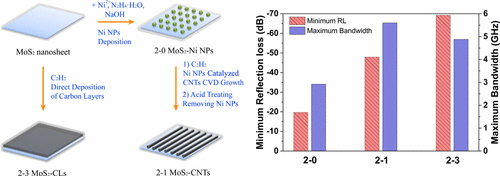当前位置:
X-MOL 学术
›
ACS Appl. Mater. Interfaces
›
论文详情
Our official English website, www.x-mol.net, welcomes your feedback! (Note: you will need to create a separate account there.)
MoS2-Based Mixed-Dimensional van der Waals Heterostructures: A New Platform for Excellent and Controllable Microwave-Absorption Performance
ACS Applied Materials & Interfaces ( IF 9.5 ) Pub Date : 2017-09-20 00:00:00 , DOI: 10.1021/acsami.7b10114 Yuan Sun 1 , Wei Zhong 1 , Yuanqi Wang 1 , Xiaobing Xu 1 , Tingting Wang 1 , Liqian Wu 1 , Youwei Du 1
ACS Applied Materials & Interfaces ( IF 9.5 ) Pub Date : 2017-09-20 00:00:00 , DOI: 10.1021/acsami.7b10114 Yuan Sun 1 , Wei Zhong 1 , Yuanqi Wang 1 , Xiaobing Xu 1 , Tingting Wang 1 , Liqian Wu 1 , Youwei Du 1
Affiliation

|
It is widely recognized that constructing multiple interface structures for enhanced interface polarization is beneficial to microwave absorption. Here, we report our work of achieving excellent microwave-absorption performance and controlling better-defined interfaces in vertically stacked two-dimensional (2D) MoS2 with other dimensional building blocks. The optimal reflection loss and effective absorbing bandwidth (reflection loss <−10 dB) of several mixed-dimensional van der Waals heterostructures are as follows: (i) for 2–0 type (2D MoS2/zero-dimensional Ni nanoparticles), −19.7 dB and 2.92 GHz; (ii) for 2–1 type (2D MoS2/one-dimensional carbon nanotubes), −47.9 dB and 5.60 GHz; and (iii) for 2–3 type (2D MoS2/three-dimensional carbon layers), −69.2 dB and 4.88 GHz. As a result, by selected synthesis of different types of microstructures, we can regulate and control microwave-absorption properties in MoS2 mixed-dimensional van der Waals heterostructures. In addition, attributing to the better-defined interfaces generated in mixed-dimensional van der Waals heterostructures, we found an alternative strategy to improve microwave attenuation properties of 2–0, 2–1, and 2–3 samples by controlling interfacial contacts. The results indicate that mixed-dimensional van der Waals heterostructures provide a new stage for the next generation of microwave-absorbing materials.
中文翻译:

基于MoS 2的混合尺寸范德华异质结构:具有出色且可控制的微波吸收性能的新平台
众所周知,构造用于增强界面极化的多个界面结构有利于微波吸收。在这里,我们报告了我们在垂直堆叠的二维(2D)MoS 2与其他尺寸构造块中实现出色的微波吸收性能和控制更好定义的界面的工作。几种混合维范德华异质结构的最佳反射损耗和有效吸收带宽(反射损耗<-10 dB)如下:(i)对于2–0型(2D MoS 2 /零维Ni纳米粒子),- 19.7 dB和2.92 GHz; (ii)对于2-1型(二维MoS 2 /一维碳纳米管),− 47.9 dB和5.60 GHz;(iii)2-3型(2D MoS 2/三维碳层),-69.2 dB和4.88 GHz。结果,通过选择合成不同类型的微观结构,我们可以调节和控制MoS 2混合维范德华异质结构中的微波吸收特性。另外,归因于在混合维数范德华异质结构中生成的定义更清晰的界面,我们发现了另一种策略,可通过控制界面接触来改善2-0、2-1和2-3样品的微波衰减特性。结果表明,混合尺寸的范德华异质结构为下一代微波吸收材料提供了新的阶段。
更新日期:2017-09-20
中文翻译:

基于MoS 2的混合尺寸范德华异质结构:具有出色且可控制的微波吸收性能的新平台
众所周知,构造用于增强界面极化的多个界面结构有利于微波吸收。在这里,我们报告了我们在垂直堆叠的二维(2D)MoS 2与其他尺寸构造块中实现出色的微波吸收性能和控制更好定义的界面的工作。几种混合维范德华异质结构的最佳反射损耗和有效吸收带宽(反射损耗<-10 dB)如下:(i)对于2–0型(2D MoS 2 /零维Ni纳米粒子),- 19.7 dB和2.92 GHz; (ii)对于2-1型(二维MoS 2 /一维碳纳米管),− 47.9 dB和5.60 GHz;(iii)2-3型(2D MoS 2/三维碳层),-69.2 dB和4.88 GHz。结果,通过选择合成不同类型的微观结构,我们可以调节和控制MoS 2混合维范德华异质结构中的微波吸收特性。另外,归因于在混合维数范德华异质结构中生成的定义更清晰的界面,我们发现了另一种策略,可通过控制界面接触来改善2-0、2-1和2-3样品的微波衰减特性。结果表明,混合尺寸的范德华异质结构为下一代微波吸收材料提供了新的阶段。



























 京公网安备 11010802027423号
京公网安备 11010802027423号